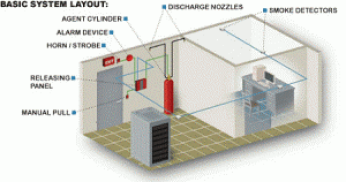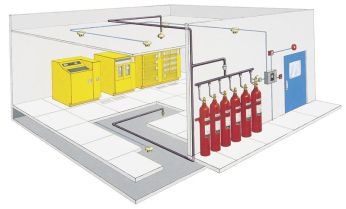Fire Suppression
The losses to businesses like yours caused by fire damage, adds up to half a billion pounds a year across the UK. However, this is insignificant when compared to the risk that fire poses to human life. This is why it’s vital to ensure your business, employees, and customers are protected by a market-leading fire suppression system that meets the most stringent regulations. We appreciate that selecting the right system can be a daunting task, which is why we are always happy to provide expert advice
Why have a fire suppression system?
So you have decided you need a fire suppression system to protect your assets. The question is why?
If it is an insurance requirement then they may have specified the type of protection they want in place, or you and your organisation may have concluded that you have a specific fire risk that needs a solution that does not rely on a member of staff to alert people and extinguish the fire.
A few points to consider:
- Your building/risk area/asset is likely to be unprotected or have no staff presence more during unoccupied hours than normal working hours.
- The type of detection available should be considered carefully, as this is the main part of a fire suppression system.
- Other areas of the risk should be considered, can the fire spread to other areas away from the risk.
- What is the potential down time of the equipment/asset if there was a fire? Try and work this out in production hours lost or business interruption as well as the cost of the asset.
- What will the system need to interface with?
- What is my organisations’ policy on agents/sustainability that could potentially be used for suppressing the fire?
- Have you considered any clean up requirements after discharge of the agent?
- Will I need a spare reserve of agent should the system trigger (down time for re-fill and re-charge can be up to 10 working days)?
- What agent is suitable and could it cause damage - e.g. water is not the only solution.
- Will I need to vent the area after discharge?
- Does the area I am protecting have good integrity – will it retain the agent to suppress the fire?
How do fire suppression systems work?
The fire is suppressed by releasing an agent onto the risk. This suppresses the fire by either reducing the oxygen (inert gases, foam, Ansul, CO2), chemical reaction with the atmosphere (synthetic gases - FM200 or HFC227eA) or cooling the fire (water mist, sprinklers, CO2)
A fire is detected by either manual detection (break glass call points) or automatic fire detection (smoke detectors, heat detectors or filament fracture bulbs). These detectors then operate the main panel which in turn releases the agent.
Detection generally has to be double knock (co-incidence) to stop the accidental release of agent which is usually the costliest part of the system. This is nearly always the case in data/server/communication rooms but may not be the case when protecting assets such as machinery, for example, with heat probes.
Its important to determine exactly what you want to achieve. In most cases the solution is down to the designer getting the correct information from you and understanding the risk. A lot of designs can be bespoke unless it’s a data room - then rigid standards over and above the norm apply.
People can sometimes be ill-informed (unless a specialist fire consultant) of the requirements, risks, considerations and solutions available so don’t be afraid to ask the reason why a particular solution has been specified.
For more information on how we can help install, repair or maintain your property, call us today on 0800 77 20206 or email info@durcans.co.uk
We offer a no obligation assessment and quotation.




